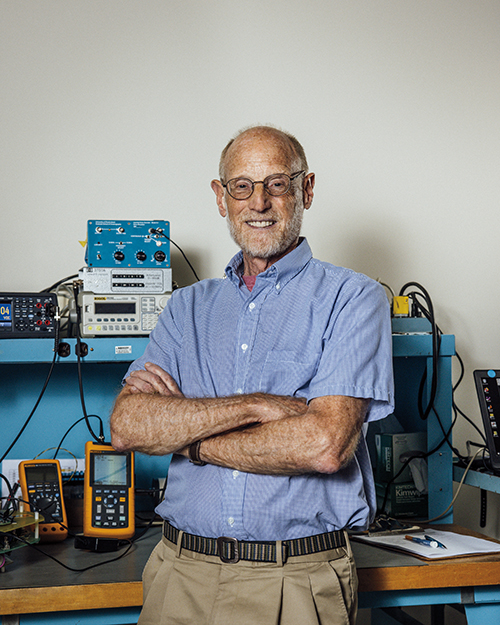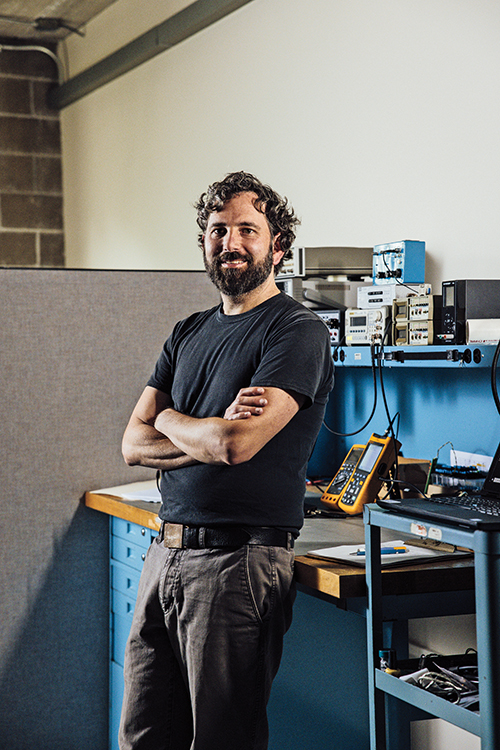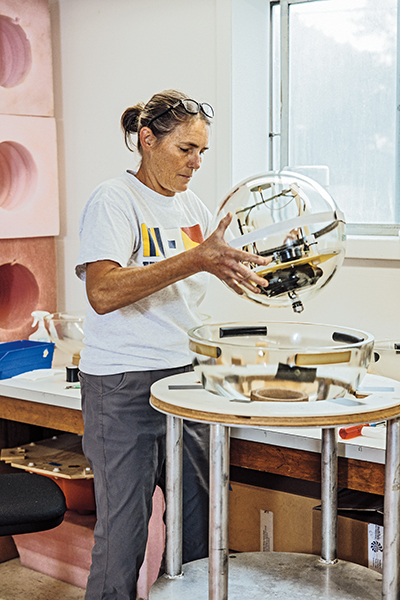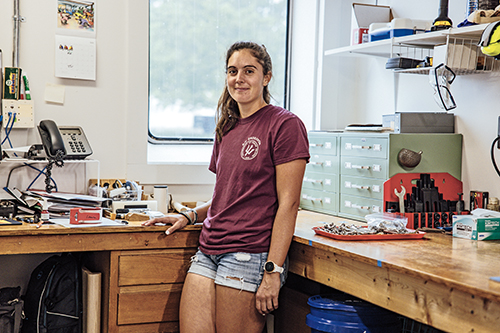Building an Ocean Expedition
What it Takes to Study the Oceans
By Hugh Markey | Photographs by Jesse BurkeWhen we think about scientific explorations of extreme regions like the Antarctic, we often picture researchers braving the elements aboard a high-tech oceanographic vessel. We may give little thought to the mechanical engineering—and the carpentry, plumbing, and electrical work—needed to make the instruments function in freezing conditions and under the tremendous pressure of the deep ocean. But a successful research expedition relies on the skills—and grit—of a varied host of experts.
PART ONE: The Prof
University of Rhode Island Professor of Oceanography Randy Watts is standing in a room the rough size and appearance of a storage closet. On the gray aluminum shelves rest dozens of electronic units that resemble nothing so much as high school science fair projects. These instruments are in varying stages of teardown, testing, and rebuilding for making a trip of some 10,000 miles for deployment in the Southern Ocean to study underwater storms.
Watts explains: “In the ocean, underwater ‘storms’ cause strong currents with pressure and temperature changes from sea surface to sea floor, much like happens in atmospheric storms. Currents like the Gulf Stream meander in wide sweeping paths as a dramatic aspect of the underwater storms. This is analogous to how the atmospheric jet stream meanders as it crosses the USA, bringing many different weather patterns. Surface currents affect shipping. Subsurface and deep currents affect commercial fishing and can pose risks to offshore oil and gas operations.”
Watts says that measuring the variability of pressure on the sea bottom helps scientists map these underwater storms, analogous to the familiar behavior of high- and low-pressure systems in the atmosphere.

University of Rhode Island Professor of Oceanography Randy Watts.
“We determine how the oceanic temperature pro-files change by transmitting a ping of sound upward from the ocean bottom to reflect off the sea surface and measuring the round-trip travel time for the echo to return,” he says. “The speed of sound in sea water changes with water temperature and density.”
Watts and his team will be using an instrument called CPIES—a combination of current meter, pressure sensor, and inverted echo sounder—to determine how ocean current, pressure, and temperature profiles vary over time in the Antarctic.
PART TWO: The Mech
Erran Sousa, uri marine development engineer, stands in the tiny workspace next to Watts. “Randy’s role is the science, and my job is to implement that. Then when the instrument collects the data he wants, I get it back to Randy. So I’m kind of in the middle of this.”
In essence, Watts and Sousa operate in two rooms. Watts makes the decisions about what type of information he would like to obtain. He then meets with Sousa, who must be familiar enough with electronics to be able to select the right pieces. “Really, I don’t know what Randy does. But I don’t think I have to, because Randy and other scientists come to me and say, ‘Here’s what we want [the instrument] to do.’ Then I say ‘Okay, I’ll work on it.’ Then it’s my job to figure out how to do that. And really, the scientists don’t know what I do either.”
While it may seem interesting to be responsible for building scientific instruments, there’s a lot of pressure as well.
“There’s a lot riding on this beyond the cost of the instruments: there’s also the cost of taking the ship out and putting them in the water,” Sousa says.
These glass globes protect instruments from water pressure at depths of nearly 20,000 feet.
And his job isn’t done once the research vessel leaves the dock. “We have piles of folders and check sheets that we run through when an instrument comes back,” he adds. He shows one of the folders with diagrams and dates. “These go back to when the instrument was first constructed back in 2003. We do that because we don’t really have many chances to get it right.”
“We test these to death and make sure we’re really confident before they leave. Sometimes it drives Randy crazy because I’ll create delays and push the time a bit, but that’s how we make it right.” After all, he says, “It’s good when things work; when they fall apart, it’s miserable.”
This expertise has value for scientists at other institutions as well—Sousa says that instruments built at uri are sold to researchers around the world.
Another part of Sousa’s job is to keep up with the thousands of new hardware components that come out every year. This familiarity informs his creativity as he searches for ways to accomplish tasks that are both effective and economical. Sousa explains: “To withstand water pressure at depths of nearly 20,000 feet, the instruments are surrounded by a thick glass globe. The challenge was that the globe would have had to have a hole drilled through it to accommodate a wire to allow for satellite communications.”
That alteration would have cost $400 per globe (and there were many globes). Then Sousa hit upon a better idea—using a Bluetooth module. The cost? $20.

Erran Sousa is the mastermind behind the technology URI oceanographers deploy around the world’s oceans.
“Some components are from those invented for phone tech, such as the Bluetooth. In other cases, [we] are using chips and micro SD cards designed for home computing, since there is enough programming on them to be useful for [the scientists’] requirements without the added expense of having to have another company fabricate a part especially for them.”
PART THREE: The Tech
The next lab used to be a poorly lit, dingy garage. Laura Reed has since renovated her workspace into a much cleaner, brighter room. Reed is a marine research specialist, known informally as a tech, and will be joining Watts on the voyage.
“I’ve been at this program for five years. It’s my job to put units together, test them, deploy them, and recover them.”
The already-limited floor space is a maze of CPIES in varying stages of preparation for deployment. Each one is placed in a white or orange hard-shelled container. The glass globes look like inch-thick salad bowls, and when seated in the containers, they resemble Sputnik satellites.
“I’ve always been a technician at URI, and I’ve had lot of different responsibilities, which helped prepare me for this.”
Reed sits beside a circular table that looks a bit like a potter’s wheel, a tool to aid in sealing the two glass halves that make up the unit. Any air inside it is evacuated. She slowly spins the globes around while wrapping an adhesive tape where the two halves meet.
From there, Reed puts the instruments through their paces. Some sit on a covered workbench, being pressure tested. Others are placed in a walk-in freezer, temperature set for the 2°C (36°F) chill they’ll encounter as they sit on the pitch-black ocean bottom. Watts says that these are built to last. “In the early days, it was a big deal to moor anything longer than two months and be able to get it back. In the last 15 years, it has become typical to deploy cpies for two to five years. Their battery packs and low energy drain and corrosion-free design give excellent success rates,” he says.
PART FOUR: The Grad Student
Thousands of miles travelled in tight quarters, rolling seas, icy conditions: perhaps not the ideal holiday cruise. Plus, there’s grunt work to be done, pitching in with some of the less glamorous aspects of a research expedition. And for grad students, there’s an additional challenge. “Sometimes graduate students tend to work sort of the tougher shifts. I think that [scientists] like having graduate students along who will be willing to maybe work the overnight shift,” says Ali Johnson, who will be deploying the instruments, potentially retrieving them in three years, and participating on the team that will process the data, which will become part of her Ph.D. thesis.
Laura Reed prepares units to measure currents, pressure, and temperature in the Antarctic Ocean.


Ali Johnson is getting hands-on experience preparing for, and participating in, an Antarctic research voyage.
Still, Johnson says, she looks forward to the voyage as a learning experience. “I think some of us as graduate students, our goal is to be the Randys and the Kathys of the world,” says Johnson, referring to her advisor and uri Professor of Oceanography Kathleen Donohue.
“And we can’t get there if we don’t learn somehow. So as an observational physical oceanographer, it’s important that [I] have this experience working with the instruments and learning how to put together a field experiment, and the resources you need, the people you need, all of that.”
This, she says, is everything she wanted in a grad-uate career. “When I was thinking about coming back to school and doing this program, one of the things that attracted me to working with Kathy Donohue and the cpies group is that this was a collaborative effort between all these different people … and that’s part of the reason why I’m so excited to be going on this cruise.”
PART FIVE: The Team
As a youngster, Randy Watts looked at trash collection days as an adventure. He would prowl the neighborhood searching for old radios, TVs, and other electronics. He’d haul them home and putter with them, learning about what made them tick. Then, in grad school, he focused on becoming a low-temperature physicist. To do the type of research he needed, often in temperatures that were close to absolute zero, Watts created some of his own equipment. Courses in electronics helped him, but there was a steep learning curve.
“I had to become a decent plumber, in a way, and a machinist because we might have to machine down the different flanges that we’d work with and then solder them onto stainless steel surfaces. They had to be really, really tight. I had to be a bit of a plumber, an optician, and an electronics person since most of the electronics couldn’t be bought off the shelf. You got into a whole lot of things to make this equipment work.”
Dramatic advances in electronics and science procedures have meant that Watts now relies on the diverse expertise of his colleagues rather than continuing to try to be a jack-of-all-trades. “It used to be that [the instruments] were simple enough to solder them right here, but now they have to be done by machine.”
It’s one example of many where Watts emphasizes the most critical element in putting together a successful science expedition: “This really is a team effort here. There are an awful lot of people making this happen.”
Contact Us
Telephone: (401) 874-6805
Email: allard@uri.edu
Contributor Guidelines
Please review submission guidelines to be considered. d

